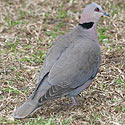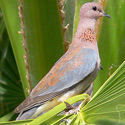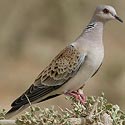|
Streptopelia (turtle
doves)
Life
> Eukaryotes >
Opisthokonta
> Metazoa (animals) >
Bilateria >
Deuterostomia > Chordata >
Craniata > Vertebrata (vertebrates) > Gnathostomata (jawed
vertebrates) > Teleostomi (teleost fish) > Osteichthyes (bony fish) > Class:
Sarcopterygii (lobe-finned
fish) > Stegocephalia (terrestrial
vertebrates) > Tetrapoda
(four-legged vertebrates) > Reptiliomorpha > Amniota >
Reptilia (reptiles) >
Romeriida > Diapsida > Archosauromorpha > Archosauria >
Dinosauria
(dinosaurs) > Saurischia > Theropoda (bipedal predatory dinosaurs) >
Coelurosauria > Maniraptora > Aves
(birds) > Order: Columbiformes > Family:
Columbidae
Species indigenous to southern Africa
|
Streptopelia
capicola (Cape turtle dove) The Cape
turtle-dove is extremely common, and is found everywhere in southern Africa
except coastal Namibia. It lives in most types of woodland, as well as
farmland, suburban parks and gardens. It mainly eats seeds, as well as
fruit, nectar, leaves and insects. It usually makes its own nest, out of
twigs, leaves and roots, but can also use nest from previous seasons and
nests made by other birds. It lays 1-4 eggs, usually 2, which are incubated
by both sexes, for 13-16 days. The nestlings stay in the nest for 16-17
days, after which they are dependent on their parents for 12 more days,
before becoming fully independent. |
 |
|
Streptopelia decipiens
(African mourning dove) The African mourning dove
lives in small areas in the northern
half of southern Africa, where it is locally common. It lives in moist savanna,
cultivated areas and riverine Acacia woodland. Its diet consists mostly
of seeds, with very small amounts of fruit and insects. The female builds a nest of twigs, leaves and roots, the male gathering
the material. It lays 1-2 eggs, which are incubated for 13-14 days (recorded in
captivity). The chicks stay in the nest 15-18 days. |
 |
|
Streptopelia semitorquata
(Red-eyed dove) The Red-eyed dove is common in many areas of southern Africa,
and has adapted very well to living with humans. It lives in most types of
woodland, especially alien tree plantations. It forages on the ground, looking
for seeds, nuts and bulblets. It usually builds it own nest out of twigs and
grass, but can also use stick nests made by other birds. The female lays 1-2 eggs, which
are incubated by both parents for 14-17 days, after which the chicks hatch. The
brood stays in the nest for 15-20 days, before leaving. |
 |
|
Streptopelia senegalensis
(Laughing dove) The Laughing dove is abundant in
southern Africa, as it is found everywhere except coastal Mozambique. It has
benefited greatly from habitat disturbance by humans, and is found in all of
woodlands, as well as suburban parks and gardens. It mainly eats seeds, with
fruits, bulbs and nectar making up the rest of its diet. The female normally
makes its own nest, while the male collects material. It lays 1-6, usually 2
eggs, which are incubated by both sexes, for 12-14 days, after which the
chicks hatch. They leave the nest at 12-13 days old, before they have even
learnt to fly. At 3-4 days after leaving the nest, the chicks can fly, after
which they become fully independent. |
 |
|
Streptopelia
turtur (European turtle-dove, Eurasian turtle-dove) |
 |
|
